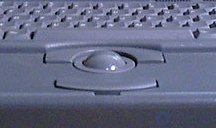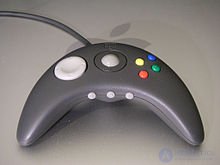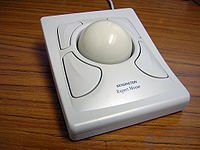Lecture




Trackball (born trackball , pronounced / ˈtrækˌbɔːl /) is a pointing device for entering information about relative movement for a computer. Similar to the mouse on the principle of action and functions. The trackball is functionally an inverted mechanical (ball) mouse. The ball is on top or on the side and the user can rotate it with his palm or fingers, while not moving the body of the device. Despite external differences, the trackball and the mouse are structurally similar - when moving, the ball rotates a pair of rollers or, in a more modern version, it is scanned by optical displacement sensors (as in an optical mouse).
The trackball models on the market differ significantly. First of all, the trackballs are distinguished by the placement of the ball: on some models it is controlled by the thumb, on others it is located in the center or to the right of the center and is controlled by the index, middle and ring fingers. On most models, the ball reaches 3-6 cm in diameter, but there are also models with a ball about 1 cm in diameter. Almost all models except the ball and buttons also have a scroll wheel.
Many fans of this manipulator trackball is convenient not only because it does not require space to work with it, but also because the hand remains stationary at the wrist during operation. [ source not specified 1955 days ]
For example, the manufacturer of trackballs ITAC Systems, Inc. claims that after 4 hours of active work with the mouse, as a result of fatigue of the wrist, the hand becomes up to 60% weaker, while the use of the trackball does not affect the studied parameters. [one]
For the same reason, some also prefer graphic tablets.
There were old models of mobile PCs (i386), to which the trackball was rigidly fastened on the side. When working, the hand lay on the surface of the table in a natural way, located on the right, partly under the trackball. This position of the hand gave a load only to the muscles associated with the big (ball) and index (button) fingers, which provided the greatest comfort.
Currently, trackballs are rarely used in home and office computers, but have found application in industrial and military computers, ultrasound diagnostic devices, where the user has to work in conditions of lack of space and possible vibration.
So, trackballs are used in the cockpits of the S-300 missile system. [ source not specified 1955 days ] and ACS ZRV - such as Baikal - 1. The official "military" name of this device is a ball-and-pinion mechanism, in the terminology of the C-300 is a spherical guidance body (SHON).
Some gamepad models, such as Space Orb, have a built-in trackball. The trackball is used in the HTC Hero and HTC Dream communicators and some Blackberry models.
Comments
To leave a comment
Electromechanical devices of electronic devices
Terms: Electromechanical devices of electronic devices